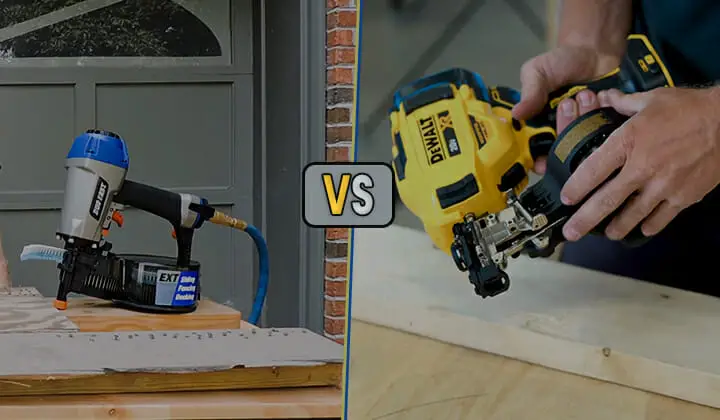To use a pneumatic nailer safely, always wear safety glasses, connect the air hose securely, ensure the nailer is set to the correct depth, and never point it at yourself or others. Maintain a firm grip and understand your nailer’s trigger mechanism to fire nails accurately and prevent accidental discharge.
Hey there, fellow DIYers and woodworkers! Jack here from Nailerguy. Ever look at a pneumatic nailer and feel a little… intimidated? I get it. These tools are powerful, and with great power comes the responsibility to use them safely. But don’t let that stop you from tackling those amazing projects that a nailer can make so much easier. We’re going to walk through everything you need to know to use your pneumatic nailer with confidence and, most importantly, without any scary mishaps. Ready to nail it?
Table of Contents
Why Safety First with Pneumatic Nailers?
Pneumatic nailers are incredible tools. They can drive nails faster and more consistently than by hand, making projects like building decks, framing walls, or even just assembling furniture a breeze. But because they use compressed air to shoot nails with force, they demand respect. A moment of carelessness can lead to serious injury. My goal is to demystify these tools and show you just how simple and safe they can be when you follow a few key principles. Think of this as your friendly guide to becoming a nailer pro!
Understanding Your Pneumatic Nailer
Before we even think about firing a nail, let’s get acquainted with the tool itself. Most pneumatic nailers have a few key parts you should recognize:
- Nose/Contact Tip: This is where the nail exits. It also houses the safety mechanism that must be pressed against the material to allow firing.
- Trigger: This initiates the firing sequence once the nose is depressed.
- Magazine: This is where you load the nails.
- Air Inlet: Where you connect the air hose.
- Depth Adjustment Dial: Lets you control how deep the nail is driven.
- Safety Mechanism: Usually integrated into the nose, this is a crucial part that prevents accidental firing.
It’s super important to read your specific nailer’s manual. They all have unique features and safety considerations. You can often find digital copies on the manufacturer’s website if you’ve lost yours.
Essential Safety Gear: Your First Line of Defense
This is non-negotiable, folks. You wouldn’t go to the range without ear protection, and a nailer isn’t much different. Here’s what you absolutely need:
- Safety Glasses: Always, always, always wear safety glasses or goggles. Small pieces of wood or even nail fragments can ricochet. A good pair of ANSI Z87.1-rated safety glasses is your best bet.
- Hearing Protection: Nail guns are loud! Use earplugs or earmuffs to protect your hearing from damage.
- Gloves: Work gloves can provide a better grip on the tool and protect your hands from splinters and abrasions.
- Sturdy Footwear: Protect your feet from dropped tools or nails.
Setting Up Your Air Compressor and Hose
Your nailer is only as good as the air powering it! Here’s how to get your compressor and hose ready safely:
1. Choosing the Right Compressor
Not all compressors are created equal. Your nailer’s manual will specify the required PSI (pounds per square inch) and CFM (cubic feet per minute). Make sure your compressor meets or exceeds these requirements. A compressor that’s too small will struggle and can lead to inconsistent nailing.
2. Connecting the Air Hose
Use a high-quality air hose rated for the pressure your compressor delivers. Couplers and fittings should also be robust and designed for pneumatic tools.
- Ensure both the compressor’s outlet and the nailer’s inlet are clean and free of debris.
- Connect the hose to the compressor first, ensuring a snug fit.
- Crucially, never connect the air hose to the nailer while the compressor is running or pressurized.
- Attach the air hose to the nailer’s air inlet.
- Check for leaks by listening for hissing sounds after you turn on the compressor.
A common and useful fitting is the industrial “m-style” quick-connect. Make sure your connections are secure. You can learn more about air hose basics from resources like USA Weld’s guide to air hoses and fittings, which offers practical insights.
3. Setting the Air Pressure (PSI)
This is critical for both safety and performance. Too much pressure can damage the nailer or overdrive nails, making them pop through the other side of your material. Too little pressure won’t drive the nails effectively.
- Refer to your nailer’s manual for the recommended operating pressure range.
- Adjust the regulator on your air compressor to set the pressure.
- It’s often best to start at the lower end of the recommended range and adjust upwards if needed.
- Test fire on a scrap piece of wood to check nail depth.
4. Understanding CFM
CFM (Cubic Feet per Minute) is about the volume of air your compressor can deliver. Nailers consume air. A higher CFM compressor ensures you have enough air to power the nail gun consistently, especially if you’re firing rapidly. If your compressor is struggling to keep up, you’ll notice the nailer’s power drop.
Loading Nails Safely
Loading your nailer is a straightforward process, but it’s another point where safety is key. Always follow these steps:
- Disconnect Air and Release Pressure: BEFORE loading nails, disconnect the air hose from the nailer AND ensure any residual air pressure is released (check your manual for how to do this – usually by holding the trigger and depressing the nose).
- Open the Magazine: Most magazines slide open. Identify the latch or lever.
- Select the Correct Nails: Use only the type, size, and gauge of nails specified by your nailer’s manufacturer. Using the wrong nails can jam the tool and cause dangerous malfunctions. Find a reliable source for your fastener needs, such as Fastener Mart’s selection of pneumatic nails, to ensure compatibility.
- Load the Nails: Slide the nails into the magazine, ensuring they are seated correctly against the feed mechanism.
- Close the Magazine: Securely close and latch the magazine.
- Reconnect Air (if applicable): If you disconnected the air hose, reconnect it now after confirming the nailer is clear and safe.
Never dry fire the nailer after loading nails. This means firing a nail without the nose tip pressed against a surface. It can damage the driver blade and the magazine.
Operating Your Pneumatic Nailer: Step-by-Step
Now for the moment of truth! Here’s how to operate your nailer safely and effectively:
Step 1: Prepare Your Workpiece
- Ensure the material you are nailing into is stable.
- If you’re working with thin or delicate materials, consider using a backup piece or setting the depth adjustment to a shallower setting.
Step 2: Position the Nailer
- Hold the nailer firmly with both hands if possible. A good grip helps control the tool and prevents recoil.
- Place the nose of the nailer flat and firmly against the surface where you want to drive the nail.
- Never attempt to fire the nailer without the safety contact tip pressed against the surface. This is the primary safety feature!
Step 3: Fire the Nail
There are generally two types of triggers on pneumatic nailers:
- Contact Trip (Bump Fire): You pull the trigger and hold it down. Then, you depress the safety contact tip against the workpiece to drive a nail. Releasing the contact tip or trigger stops firing. This is faster for sequential nailing but requires extra caution.
- Sequential Trip (Full Sequential): You must first depress the safety contact tip against the workpiece, then pull the trigger to fire a nail. You must release the trigger and then release the contact tip before firing another nail. This is slower but offers maximum control and safety.
Check your manual to see what type of trigger your nailer has and how to operate it. For beginners, sequential trip is generally recommended for better control.
Step 4: Drive the Nail
Once the contact tip is pressed and the trigger is activated (according to your trigger type), the nailer will drive a nail. Apply firm, steady pressure.
Step 5: Adjust Depth if Needed
If the nail is driven too deep (i.e., it sinks below the surface of the wood) or not deep enough (i.e., the head is proud of the surface), adjust the depth setting. There’s typically a dial or lever near the nose of the gun. Consult your manual for its specific location and operation.
Here’s a quick table to help visualize depth adjustment:
| Symptom | Adjustment | Action |
|---|---|---|
| Nail sinks too deep (overdriven) | Decrease pressure / Increase depth setting number (if applicable) | The nail sinks below the surface, potentially damaging the wood or creating a divot. |
| Nail head is proud (underdriven) | Increase pressure / Decrease depth setting number (if applicable) | The nail head sits above the surface of the wood, leaving it exposed. |
Step 6: Repeat
Reposition the nailer for the next nail and repeat steps 2-5. Maintain control and situational awareness.
Always Remember These Safety Rules:
To make sure you’re always using your nailer safely, keep this list handy:
- Never point the nailer at yourself or anyone else. Treat it loaded at all times.
- Always disconnect the air supply when the nailer is not in use, when loading nails, when clearing jams, and when performing maintenance.
- Ensure the safety contact tip is depressed before firing.
- Maintain a firm grip and stable stance.
- Don’t operate the nailer when fatigued.
- Be aware of your surroundings and what’s behind your workpiece. Nails can go through thin materials.
- Keep fingers away from the trigger when not actively firing.
- Never remove or disable safety features.
Clearing Jams: A Common Challenge
Jams happen, even to the pros. The key is to clear them safely.
- Disconnect Air: First and foremost, disconnect the air hose!
- Release Pressure: Ensure all air pressure is released from the tool.
- Locate the Jam: Look into the magazine and nose to identify the jammed nail.
- Use Pliers (if necessary): If a nail is stuck, you might need a pair of needle-nose pliers to gently pull it out. Be careful not to damage the driver blade or magazine.
- Refer to your manual: Some nailers have specific procedures or tools for clearing jams.
- Test Fire (carefully): After clearing the jam, reconnect the air and test fire on scrap wood to ensure it’s working correctly before resuming your project.
A well-maintained tool is less likely to jam. Regularly cleaning and lubricating your nailer according to the manufacturer’s instructions is a great preventative measure. Resources from organizations like the Occupational Safety and Health Administration (OSHA) provide detailed guidelines on the safe use of powered tools, which includes pneumatic nailers.
Different Nailer Types and Their Safety Nuances
While the core safety principles remain the same, different types of nailers have slight variations:
- Framing Nailers: These are powerful and often have contact trip mechanisms for rapid firing. Extra caution is needed due to their strength and speed.
- Finish Nailers: Used for trim and molding, they deliver smaller nails and often have sequential trip triggers, offering good control for detail work.
- Brad Nailers: Similar to finish nailers but use even smaller brad nails. They are generally less powerful but still require full safety adherence.
Regardless of type, the commitment to safety must never waver.
Maintenance for Longevity and Safety
A well-maintained nailer is a safe nailer. Here’s what you should do:
- Lubrication: Add a few drops of specialized pneumatic tool oil to the air inlet after each use or as recommended by the manufacturer.
- Cleaning: Keep the exterior clean. Periodically clean the magazine and nose area to prevent debris buildup.
- Inspection: Regularly inspect the tool for any damage, loose parts, or worn O-rings.
- Air Quality: Use filtered air if possible. Water or oil contamination can damage the tool’s internal components over time.
Neglecting maintenance can lead to performance issues and increased risk of jams or malfunctions, jeopardizing your safety.
Frequently Asked Questions About Pneumatic Nailer Safety
Q1: Can a pneumatic nailer fire a nail if the safety tip isn’t pressed?
A1: No, not if it’s functioning correctly. The safety contact tip is designed to prevent the nailer from firing unless it’s pressed against a surface. This is a critical safety feature.
Q2: What’s the best way to avoid accidental nail gun injuries?
A2: Always disconnect the air supply when not actively nailing, never point the gun at anyone, keep fingers away from the trigger when not in use, and always wear safety glasses.
Q3: How often should I lubricate my pneumatic nailer?
A3: Most manufacturers recommend adding a few drops of pneumatic tool oil to the air inlet after each use. Always check your tool’s specific manual for the best lubrication schedule.
Q4: What if my nailer jams?
A4: First, disconnect the air supply. Then, release any residual pressure. Identify the jam and carefully remove the incorrect nail, perhaps with needle-nose pliers. Consult your manual for specific jam-clearing instructions.
Q5: Do I need to wear hearing protection with a nail gun?
A5: Yes, absolutely. Nail guns are loud and can cause hearing damage over time. Always use earplugs or earmuffs when operating one.
Q6: Can I use any type of nail in my pneumatic nailer?
A6: No. You must use the specific type, size, and gauge of nails recommended by the nailer’s manufacturer. Using incorrect fasteners can cause jams, damage the tool, and create a safety hazard.
Conclusion: Nail Smarter, Not Harder
So there you have it! Using a pneumatic nailer safely is all about understanding your tool, respecting its power, and following a few simple, tried-and-true safety practices. From the essential safety gear to proper setup, loading, and firing, you’re now equipped to tackle your projects with confidence. Remember, safety isn’t just a rule; it’s a habit that will protect you and ensure your woodworking journey is enjoyable and successful. Now go forth and build, safely and skillfully!



